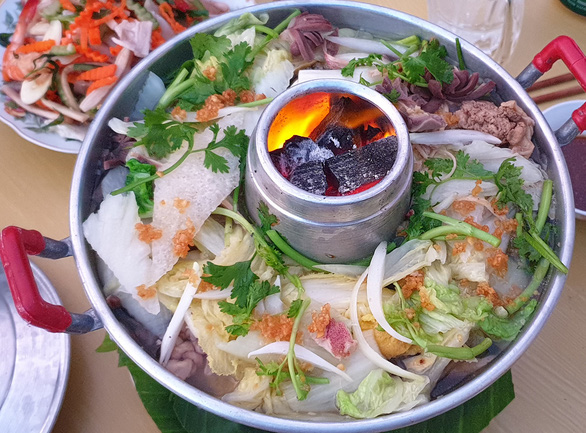Far from a traditional banquet staple, the classic steamboat hotpot embodies the very essence of Vietnam’s Mekong Delta, where the abundance of the land, the skills of the people, and time-honored formalities melt into one distinct meal.
Hotpot, or “lau” as it’s known in Vietnam, is loved throughout the country thanks to the bonding experience it provides diners. Typically, a hotpot in Vietnam is comprised of using a pot of boiling broth placed on the table to cook meat, veggies, and other side dishes.
In southern Vietnam, the most storied style of hotpot is “lau cu lao,” or “isle hotpot,” which sets itself apart from other styles of hotpot thanks to a chimney which rises from the middle of the pot that allows the smoke and heat to escape from below.
The dish is typically comprised of a myriad of Mekong River delicacies meant to strike a chord of nostalgia amongst those born and raised in the Mekong Delta region.
According to Nam Phuoc, a celebrity chef on Son Islet in the southern city of Can Tho, the Mekong Delta’s vintage steamboat hotpot differs from other hotpot styles due to its focus on presentation.
Lau cu lao’s base – a stock prepared from pig shin bones, chicken wings, and chicken legs for the stock, as well as pieces of daikon, yam bean, dried squid, and dried shrimp – is typical of most hotpot recipes.
However, what truly defines vintage steamboat hotpot is the assortment of meat and veggies that diners can cook in the stock.
Within the Mekong Delta region, each province seems to have its own preferences for ingredients. For example, diners in An Giang and Dong Thap Provinces, tend to prefer fish while residents in Ca Mau, Bac Lieu and Kien Giang Provinces often choose fresh shrimp and squid.
The ingredients also depend on how well-off the host is, but essentials typically include flower-shaped meatballs made from bronze featherback fish, pig liver, poultry giblets, and carved veggies.
Steamboat hotpot feasts begin once the first ingredients are added to the pot and burning coal is placed into the tube in the middle. A few minutes later, once the pot starts to boil, a lid is placed on top. Diners know it’s time to dig in once steam starts seeping from the lid.
Once a centerpiece served during every southern banquet, steamboat hotpot seems to have fallen out of grace with the introduction of mini electric and gas stoves. Still, the dish has yet to disappear and can still be found at eateries throughout the region.
Like us on Facebook or follow us on Twitter to get the latest news about Vietnam!



























